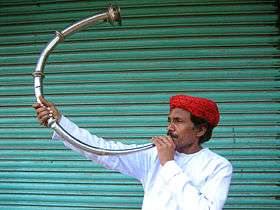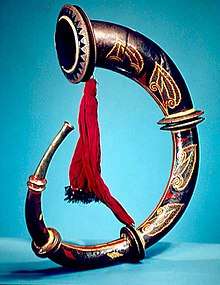Sringa
The sringa, also known as tutari, ranasringa, blowhorn, sig, singa, kurudutu or kombu, is an ancient Indian musical instrument. It is a type of horn wind instrument.

Mumbai player of tutari
Construction
There are two shape types of bugles, one made in "S" shape, and the other in "C" shape. Material was originally made of animal horn, and of metal.
Playing

Ranasringa dated to 1880, currently in the collection of the Metropolitan Museum of Art
The tutari in Maharashtra, has survived not just because of its connections to royal traditions, but as a current political symbol. The instrument is also executed in South India, in Sri Lanka, and Nepal. It is played for festivals, and in ritual performances known as kshetram vadyam. It is also played for marriages and in military music.
gollark: Computers are great because they can keep my desk warm.
gollark: I rarely have enough pockets.
gollark: This is an uncool thing which I think is mostly just put in by lazy authors/gamedevs for balance.
gollark: Not because those are impossible to automate but because if someone does automate them I will likely have bigger issues than "oh no, I no longer have a job".
gollark: Anyway, I figure I should be *relatively* safe from automation if I work in somewhat creative technical fields and/or designing automation systems myself.
See also
Sources
- S. Sadie, The New Grove Dictionary of Musical Instruments, Macmillan Publishers, London, 1985.
This article is issued from Wikipedia. The text is licensed under Creative Commons - Attribution - Sharealike. Additional terms may apply for the media files.
